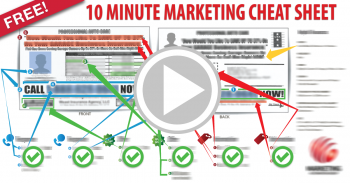Category Archives for Business

A Powerful Lesson From My Mentor
Years ago, I learned something from my mentor that
has proven to be more valuable than most other things.
I’ve used this specific thought process to ‘fix’ many
businesses and get the cash flowing again rapidly.
Here’s this nugget of wisdom in it’s simplest form:
The amount of money you make is in direct proportion
to the number of offers you make.
That’s it, simple, yet profound.
In every instance, in every situation when I start working
with a client that isn’t hitting their revenue goals, all I
need to do is evaluate the number of ‘offers’ they are
making on a daily, weekly, monthly basis and right there
I find the problem.
So if you’re finding that you’re not hitting the revenue
numbers you’d like, ask yourself (and be brutally honest)
‘how many times a day am I making an offer to someone?’
Are you on the phone asking people for their business?
Are you running webinars to promote and sell your services?
Are you doing live presentations?
Are you emailing people asking for their business?
What are you doing to make an offer?
See, when you make an offer there’s only 2 things that can
happen, 2 and ONLY 2.
1. They can say YES, I’ll take it.
2. They can say No.
But even the ‘No’ will often times turn into a ‘yes’ later on
IF YOU’VE MADE THE OFFER IN THE FIRST PLACE!
Of course NONE of this can happen if you don’t make the
offer.
So today’s lesson: Make a SHITLOAD of offers, and you’ll
make a ton of money.
Being a man that practices what he preaches, I’ve got an
offer for you. Right now I’m offering to do no charge
strategy sessions for REAL business owners who are doing
more than 100k a year in sales and want to get to the 100k
a month level and beyond.
If you think you’re ready for some no nonsense, clear thinking
go ahead and sign up for a strategy session with me by clicking this link.
I look forward to talking with you.
Yours in profit,
– Bob
P.S. Clear thinking is responsible for more business success than
everything else combined. If you’ve become clouded or ‘stuck’ in
your business, then a strategy session with me might be the
exact thing you need to get ‘unstuck’ and moving again. Click here to schedule yours now.
Web Marketing: A Good News/Bad News Platform
I don’t think it can be overstated that the web has brought with it unprecedented power. The power to reach your potential customer and put your marketing message in front of them cheaply and easily. Everyone is on the web no matter what niche you’re in, no matter your target demographic- they are there and with some trial & error, you can reach them.
That’s the good news. Now the bad news.
Almost no one knows how to market on the web successfully. This problem stems from a few key factors. First off- unless you’re a giant corporation, with an unlimited marketing budget, you cannot use traditional marketing methods on the web (sorry advertising agencies and traditional marketing companies). Anything designed for ‘brand awareness’ or ‘top of the mind’ isn’t going to generate the one thing small business owners and entrepreneurs actually need: customers.
Secondly, as the web has evolved over the past few years, more and more advertisers and ads have crowded the web, driving up prices and making it harder to get your potential customers’ attention. There’s even a condition called ‘Banner Blindness’ now where a percentage of people subconsciously ignore banner ads when they are surfing the web. Add to this the ever changing landscape of SEO (search engine optimization- which as of the time I’m writing this, 3/15/16, is dead, IMHO) as a quick traffic strategy and you’ll begin to see why so many people struggle to get any traction with their web marketing efforts.
So what can you do to enjoy success, while others fail? The answer is simple, but not easy.
To start, you’ve got to use the time tested and proven methods of direct response marketing. The web was literally made for this kind of advertising and it’s what every successful marketer and business owner I know uses. I’ve discussed this in previous blog posts.
The next success tip I’ll share with you is more of a mindset than a tangible thing- but it’s the most important part. You have to approach your efforts at web marketing with the mindset of ‘cracking the code’, and in reality it’s more like a 4-5 different codes. The overwhelming majority of people make a few feeble attempts at marketing online and then quit when they don’t see results. I like to tell my clients that they are mining for gold, and the web has a treasure chest of it- but that chest has a series of combination locks on it. In order to be successful online, you’ve got to figure out (dial in) the combination of each of these locks before you’ll get the gold (almost unlimited clients). Most importantly, you’ve got to have the emotional fortitude to go through test after test, trial and error with unwavering determination.
So what are some of these ‘locks’ you’ll need the combination to? Here’s a quick list of my top 6:
Where are my potential customers online? What websites, forums, etc.
What message ‘words’ will they click on?
What ‘image’ will they click on?
Are the clicks you’re getting from “qualified” prospects?
Can we improve on the “best” performing ads? (increase CTR- click through rate)
And lastly, do the clicks we’re getting convert to paying customers?
There are many more than this quick list but this represents a good start. Keep in mind that the lesson here is you’re always testing, working and refining your online marketing. You need to approach this task as an on-going effort, not a one and done type task.
Keep the right mindset, and your success is virtually guaranteed, because your ideal customer is online and with a little perseverance you will find and convert them to your customer, unlocking that chest of gold.
When you’re tired of beating your head against the wall and want proven, time tested methods and strategies that flat out work- bringing an avalanche of red hot customers to your door, then you need to grab a copy of Automated Entrepreneur Method right now. Save yourself countless hours of trial and error and get the shortcut to success right now.
You’ll also want to attend my webinar where I cover this topic and many more in depth. You can register for that here.
Yours in Profit,
Bob
The Power of FOCUS
 If there’s one thing that I can say is the single biggest factor to a person’s success- it’s their ability to FOCUS.
If there’s one thing that I can say is the single biggest factor to a person’s success- it’s their ability to FOCUS.
A few years ago I learned that the word FOCUS is an acronym meaning: Follow One Course Until Successful.
This may sound easy, but in reality I’ve found it to be very difficult, especially when it comes to building your business.
In any given business, on any given day, there are just too many things to focus on, too many things pulling you in all different directions. Things like accounts receivable (getting paid), accounts payable (paying bills), employee or contractor management, product development, fulfillment, customer relations, brand messaging, payroll, cash flow management and many, many more… And yet none of these activities, all demanding your attention, address what Michael Gerber identified as the most important. None are working ‘on’ your business. They are all working ‘in’ it.
This is where the power of FOCUS comes in. If you want to rapidly scale your business from 6 figures a year to 7, you must focus on the activities that build your business, not just manage it.
What are some of those things?
My favorite, and I believe the most important, is marketing. As I define it, marketing is everything that causes a potential customer to notice you and causes them to want to choose your business over anyone/everyone else.
I’d like to say that until a business has figured out how to attract a constant and predictable flow of high quality customers, ready to do business with you, you shouldn’t be focusing on anything else. Sure paying the bills has to get done, as do many of those other ‘in your business’ activities, but none really matter until you’ve got loads of people waiting to give you their money.
FOCUS on that first, and keep at it until you’ve achieved that goal and I guarantee you’ll have a 7 or even 8 figure business very soon.
If FOCUS is a challenge for you, and you’d like specific, and proven marketing methods, strategies and tactics that deliver top quality customers to your business 24/7, then you’ll want to get your hands on my Automated Entrepreneur program right away. You can learn more proven FOCUS techniques and killer marketing strategies on my webinar, that you can attend for free, just register here.
Yours in Profit,
Bob
Small Business Growth—How Fast is Too Fast?
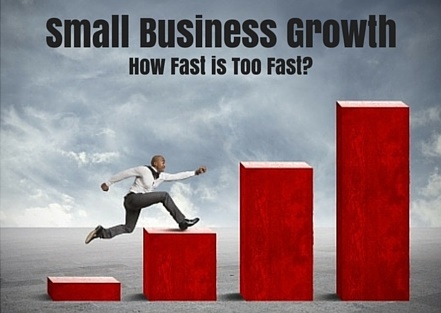 Start small, grow fast, make a million dollars, sell, repeat. Sound good? Not so fast.
Start small, grow fast, make a million dollars, sell, repeat. Sound good? Not so fast.
From start-up to corporate enterprise, the message is clear—grow fast. But, in an economy with unicorns starting to trip over themselves, the decision to accelerate growth has to be made cautiously.
As a business growth authority, I work closely with my clients to investigate when the time is right—or not—to make your small business a bigger business.
Knowing when to expand, and how to do it successfully, is critical to your growth plans, and maybe the survival of your business. First, let’s take a look at some signals that reveal it is not a good time to push fast expansion:
- Lots of sales, not much money: Most people believe the way to save or grow their business is to increase sales. All you need to do is bring home that next contract. Sales are great, but if you don’t have the infrastructure in place, you are not growing—you are just making more sales.
- You are a debt collector: You made more sales, but you are cash poor with a lot of sales on account. That is not growth, that is a potentially failing business.
- High expenses, low revenue: This one is easier to see. You are paying out more than you are pulling in. Scale up too fast, blow through your capital investment, and collapse. If new financing does not come through, yours is not the first start-up to become a wind-down.
- You ignore your business model: You’re doing pretty well in a niche business, have a couple of locations, and built buzz around the quality of your product and pleasant customer service. If some is good, more must be lots better. You obtain financing, sell out on your quality concept, and go big time with a chain of new locations. Your product and service reputation start to slide.
- Too much work, too little time: Although you, and key employees, work too much, you decide to gear up for growth. You are so busy that customers are complaining, and there are quality issues. But again, if you have more sales, you think you won’t have to work so hard.
Stop. These are signs of a business out of control, not one ready for growth. So how should you think about growing your business?
Steps for safe business growth
The right growth strategy for you is not the growth strategy that worked for somebody else. Though you may sell the same product, the similarity ends there. Your financial statement, goals, and history are different than the other guy or gal. That means your best move is to work individually with an advisor who knows business—and knows how to ramp up your profits.
Business growth and increasing revenue are not the same things. While you hope one leads to the other, I work with the whole picture when I talk to you about business growth. Depending on your unique goals, and spreadsheets, I might suggest steps that include:
- Segment: Are you serving the right corner of the economy? A close look at your product and your market shows whether you can further exploit your natural business niche. Looking at market segmentation means carefully understanding the type of client, or customer, you want. You are better off aiming your marketing and business development effort at a defined audience segment that wants to pay for your product, than blowing your brand budget on scattershot marketing to try and sell to the world. A refined focus on your true segment can earn you more profit.
- Service: Once you define your market, think about an additional service you can add to serve that market. Listen to your customers—what are they looking for? Where are they going after they spend money with you? Can you identify a parallel product or service that pushes your deliverables—but does not require you to start up a whole new unit? Working with a business advisor, and good market data, is a good way to approach this type of expansion.
- Partner, acquire, merge: Mergers and acquisitions are not just for big companies. Look around for other entrepreneurs who might offer a complimentary business, or service. Individually, your separate small businesses could do okay, or maybe struggle. Considering a partnership or an acquisition is a fast way toward growth and increased revenue if the fit is right, and the infrastructure merger is handled well.
Growth may look good, but not if your small business crumbles under the weight. When you are ready to expand, or looking for how to stabilize your business for growth, I hope you will contact me to talk about your best options for moving up. You can reach me at (585) 633-7563.
Yours in profit,
Bob Britton
Content Marketing—What Should it Mean to You?
 We talked about CRM earlier—now I’m going to talk about CM, or content management.
We talked about CRM earlier—now I’m going to talk about CM, or content management.
Not only is content management driving marketing efforts these days, but CM is big business—providing work for lots of people along the marketing and customer service pipeline.
There are many types of content—but first, what is it? Here are a couple of points to keep in mind:
- Content takes many forms and is used throughout a small business, or organization.
- High quality content is important. The days of copying articles from other websites and posting it up on your own site are done.
- Content gives you the chance to create, nurture, and maintain contacts with customers, and future clients.
So, content marketing is pretty much the business of using different types of content to get your message across to your audience, and even, to your competitors.
Content marketing is mostly conducted online—helping you attract targeted leads. Maybe you remember buying bulk mailing or email lists? The days of casting a big net to see what swims into it, are done too. Content marketing means crafting a unique message for just the right kind of customer.
Types of content that could help—and how you use it
If you are an entrepreneur, it is likely you run a pretty small shop. Small- to medium-sized businesses cannot afford a whole team of marketing people on the payroll.
Since marketing is now the bigger part of sales, blending these efforts is essential. Consider outsourcing your marketing needs to a specialist you can use to create a targeted content marketing strategy—and execute on it. Outsourcing is also a super idea for creating content, because an outsourced specialist knows how to write, and create, the content you want.
While you need to deeply engage in developing a marketing strategy that works best for your small business, this does not mean you have to create the content. As I have said many times before, only do the work that only you can do.
Basically, your focus as a small business owner is to create interesting, focused content, make sure it is optimized for the web, and manage social media channels. What you do depends largely on your budget, your goals, and your audience.
Here are some different types of content that could work for you:
- Education: Consumers are doing their research before first contact with your product or service. They may have visited half a dozen websites and done some reading before they landed on your website. Offering good quality, compelling information that helps them make the right choice is the first step toward selling them on your product or service. Consider tip, or fact sheets, “How-to” pages, and links to offsite resources either that you authored or that you believe are authoritative on the subject.
- Short and long form information: A blog is a great way to serve many aspects of your business. Whether you offer information, create and communicate your company culture, discuss a recent customer service issue you solved, launch a new service or highlight an older one—a blog is an effective communications medium that serves you as long as you serve up fresh, high quality content. Feed your CRM machine by offering longer form content that is accessible only upon registering with name, email and other details that help you create a consumer profile. Create visually interesting, informative white papers and other materials that offer a look at your product, industry, or what is currently trending.
- Service: Include case studies, tutorials, YouTube content, testimonials, step-by-step, and other material to help potential customers understand exactly what value you offer, and why it will work for them. Be sure your customer service is transparent and speedy—think Amazon.com.
- Make it interesting: Don’t think the only thing you can use is a blog and text. Use infographics, podcasts, livestreamed video, cartoons, animation, slide share and more. Invite guest blogging and learn about user-generated content to help convert leads to loyal customers.
There are different kinds of content that could be right for your business. You don’t need to use everything, but you’ll want to mix it up to keep your audience—and customers—interested.
The most intriguing content in the world won’t mean anything if you do not have a strong marketing strategy, the right value proposition, and the message that puts those together in an unbeatable way.
I use experience, software , and know-how to help my clients succeed. I work with small business owners to create the message, and the business climate, to give your business the boost it needs—and the profit you want.
When you want to dig in to more money at the end of each month, give me a call at 585-633-7563.
Yours in profit,
Bob Britton
Think You are Too Small to Get Hacked? Think Again
 Too busy to believe your small business is going to get hacked? Big mistake.
Too busy to believe your small business is going to get hacked? Big mistake.
In 2015, the rate of electronic theft, fraud, and cyber invasion rocketed. Hacking is now an established criminal enterprise, and the easier the target—the more likely it is to be hacked. The average cost of a single business hack can run from $30,000 to millions of dollars. Can you afford to ignore this issue?
Entrepreneurs with fewer than 100 employees often think themselves too small to attract the interest of cyber criminals. Unfortunately, small business is a prime hacking target for a number of reasons including:
- Small businesses have financial assets worth stealing
- The intellectual property and tech owned and used by a small business makes a good target
- Because they have fewer resources, smaller firms and businesses usually do not have sufficient cyber protection
- Small businesses may provide third party access to the network of a larger, better protected company
A recent article in The New York Times notes that a single hacking incident, or a series of distributed denial of service (DDoS) attacks, can take your business down for good.
DDoS attacks occur when a bad actor aims an autobot network at your website—overwhelming and crashing your server. Your web presence and ecommerce, are dead.
Increasingly, hackers are using chaos as a diversion. While you, or a computer security expert, try to get your website back up, the hacker quietly launches malicious code which can be remotely manipulated later, when you think the crisis has passed.
When people talk about a computer virus, spyware, or adware, they are talking about malware, or malicious programs used to damage systems and steal information. Ransomware is a form of malware, and like the name implies, the software locks up your system until you pay for its release.
The problem is, payment of the ransom may—or may not—end with the happy return of your essential business files. Although hackers have a financial interest in returning your files intact, a small mistake can scramble your files, costing you not only the ransom—but your data as well.
On the cloud, or on your own server, cyber crime is a growth industry and your enterprise will eventually be a target.
Five tips to protect your small business from cyber attack
I am a business growth expert who helps clients make smart moves with their marketing—and automated marketing software. A natural computer geek, I know a few things about protecting digital assets.
As much as you may not want to deal with cyber stuff, take a deep breath and take a look at these tips. Being aware of the vulnerability of your small business is half the battle:
- Assessment: Unless it is your area of interest, chances are good you are not a cyber security expert, nor do you have one on staff. This is a good place to take advantage of outsourcing. Get referrals, make some calls, and bring someone on board to assess the security of your operation, from point of sale to data archives. Make sure you work with a company familiar with the concerns—and vulnerabilities—of small businesses.
- Education: With assessment in hand, you might be shocked to realize your vulnerability. There are resources available to deepen your understanding of how to help yourself. The Federal Communications Commission (FCC) and the Small Business Administration (SBA) offer free tips and training to help you get up to speed.
- Update and test: After you create goals and security parameters for your business, use a qualified security vendor to upgrade your system and your overall approach to online and network security. You may want to engage in penetration testing (called pen-testing) to safely gauge the effectiveness of your security update.
Train your workforce about social engineering techniques like phishing. A click on an attachment, or a safe-looking link, in an email can quickly lead to a serious data breach incident. Make cyber security a common conversation with employees, and update their knowledge frequently on best practices.
- Consider insurance: Check out cyberinsurance to cover business losses in the event you are hacked. Your costs could include liability to customers who suffer exposure or theft of personal information, the cost of managing the data breach, business interruption and more.
Be aware that rates for cyberinsurance are rising just as fast as the hacking rates. You may find insurers provide expensive coverage for less than the damage you might suffer.
Plus, some insurers and banks are pushing back on claims—litigating incidents where employee mistakes led to the breach. Another good reason for assessment, protection, and pen-testing is that you could get better rates when you try to apply for cyberinsurance.
The profit you see from your small business depends on secure doors and windows to your data, and your service. Don’t skimp on cyber security.
Just like network safety, earning more profit does not happen by accident. When you are ready to move ahead on a new plan for profit this year—I hope you call me at 585-633-7563.
Yours in profit,
Bob Britton
You Can’t Get Rich if You Don’t Get Paid
 It is the ultimate business bottom line—no pay, no profit. If you are scraping by on IOU’s, it is time for a change.
It is the ultimate business bottom line—no pay, no profit. If you are scraping by on IOU’s, it is time for a change.
You work hard to run your business, produce a product, or provide a service, and deliver on time. You expect to turn a profit by being paid in a timely way. Unfortunately, small business does not work that way a lot of the time.
According to a recent survey by cash flow tech company Fundbox, about 64 percent of their small business clients are routinely paid late. And it is not necessarily that small businesses are always the culprits too stretched to pay on their bills. It is also big clients, like Walmart and McDonald’s, who routinely pay late. Go figure.
It is hard enough being an entrepreneur without working for nothing. When you make a sale—you need to get paid.
Taking care of business—tips to make sure you see the money
You have your own bills and employees to pay, you cannot spend another week wondering when the check is going to be in the mail from your big client. The longer an invoice goes unpaid, the less likely you are to be paid in full.
Take these tips to heart, and to the bank, when you want to get serious about a cash flow problem caused by late-paying clients:
- Know your customer: When you have been in business for yourself, it does not take long to develop a sixth sense for which clients are going to pay, and which are not. But you should not have to count on experience, or telepathy, to get paid for your time or products. If you develop and deliver goods, be sure you have a contract in place to protect your profit and spell out terms of payment. Consider building a discount into your price point for clients that pay early—and don’t think twice about a percentage penalty for late pays.
Some experts counsel against a late fee, saying it is just incorporated into the cost of doing business. Bottom line? You don’t want to be doing business with people that pay late! Small businesses cannot work for those who do not pay—make your message at the outset as you discuss initial delivery and payment terms.
Be sure to stay on a first-name basis with personnel responsible for processing your bids, and contract payments with your bigger clients. You’ll be the first to know about potential payment delays, and more likely to get paid on time.
- Make it easy: There are a lot of creative ways to make the payment process faster and easier. Use top notch invoicing software, or SaaS, to ensure your invoices are delivered electronically and on time. Work closely with new clients, especially bigger companies, which have slow-moving payment systems. Do your best to incorporate their payment needs into your system, but be sure that the conversation about the ways and means to pay on time takes place. Otherwise—you do not need this client.
Set up a merchant account, and take payment by electronic transfer or credit card. Be sure there is a clear understanding of delivery and payment terms to ensure you, and your customer, are free to build and expand a good business relationship—instead of spending frustrated days and weeks trying to get paid.
- Retainers and upfront money: A lot of professionals ask for a retainer until they are sure a new client pays on time regularly. For substantial work for a new client, or with an established client with a poor payment record, get a percentage of your fee upfront. No small business owner can really afford poor paying clients. Entrepreneurs who carry unsuitable clients often end up out of business, or in bankruptcy.
- But they aren’t paying: So you have a client that will not, or cannot pay. Talk to them in person. Make a visit if you can, instead of making a call. Get the lowdown on what it is going to take to get the bill paid—even at a discount. Offering any kind of payment incentive often greases the wheels enough to walk out the door with a check. Don’t do business with these kinds of companies. If it is your big client? It is time to diversify. Unless it is a big contract, legal action is an expensive option to pursue. Consider business mediation first. It is faster and cheaper.
Best tip? Develop and manage your client list into only premium customers. I have said it before, do not compete on market price. Compete for premium clients who pay the right price—on time. By offering special perks, attention, client care, and high quality service, you are developing the kind of customer who pays on time, every time. You do not want clients looking for a break on every bill. You want the ones who come to you because they know what to expect, and they are willing to pay for it.
From here on out? No more 90-day and up overdue, you just cannot afford it. Put the right structure in place, and start attracting the kind of customer that does not quibble about paying a fair price. When you need to market your services to the clients who pay—I hope you will call me at (585) 633-7563 for help. No small business owner can get rich on an IOU.
Yours in profit,
Bob Britton
Getting Started with CRM
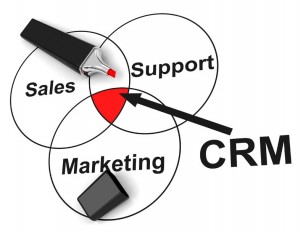 If you are an entrepreneur who is not currently using customer relationship management (CRM) software, you will be soon. Why? Because it saves you time and boosts your profits.
If you are an entrepreneur who is not currently using customer relationship management (CRM) software, you will be soon. Why? Because it saves you time and boosts your profits.
I am an expert on small business growth. My work with individual clients, and with groups, helps them become millionaires. Think about it—wouldn’t you like to make more money, and do more of what you love? At the same time, you can do less of what you don’t want to do. That could be done by someone—or something—else.
We talked last time about the different types of data and how data helps your business. But how do you manage your data in a meaningful way? That is where CRM comes in.
Learning about CRM is one of the first steps I recommend to my clients. Many small businesses get by initially by using a spreadsheet and an email list. Grow a bit, bring on a sales representative, or start getting some traction in the market, and you’ll find that keeping track of things on paper is not so easy.
Plus—storing dates, details, and customers is not the same thing as nurturing leads, activating your sales funnel, or engaging established customers.
Your CRM: What can it do for you?
In the last decade, the business of marketing has changed. While marketing used to be placing general ads, sending out brochures, and a hit or miss approach, personalization is the name of the game today. The better you capture individual consumer practices and preferences, the better able you are to meet client needs. How?
Your CRM software can handle a great deal of the labor that used to take marketing personnel many hours. From keeping track of important contact and sales information, to creating a dynamic web experience for new visitors to your website, CRM packages capture, store, and infuse your sales strategy with the information you need for leads to become conversions.
Here are some key capabilities of CRM software:
- Improve the view: With the move toward personalization, and a unique customer experience, one objective of CRM is a 360-degree client view. Because you no longer waste money on print ads, expensive brochures sent to a stale mailing list, or cold calls to uninterested consumers, the customer journey now takes center stage. When you use CRM software, you create customer profiles that allow you to segment your client base. Segmenting lets you create marketing plans for different client groups. CRM allows you to identify premium customers that pay more for the service, or product, you offer. Define those leads—or that portion of your customer base—and you have taken a first step to cultivating, capturing, and nurturing repeat business from high-margin clients.
- Keep clients on board: Customer retention is important. Spend less time creating new sales by maintaining your client base. Regular clients are more likely to buy more of your product line—and need less discount incentive to do so. Upselling is also easier with an established, satisfied customer. CRM software identifies those important clients, helps you schedule routine follow-up, and personalizes your relationship by noting important dates to send a card, gift, or discount offer.
- Targeting: Increase your revenue by ramping up your marketing strategy. By collecting data and creating focused campaigns, you push your sales message to leads, and customers, to sell your products and services. Your CRM software strengthens overall customer service since marketing and sales personnel have access to the same, fresh data. CRM software contributes to better service, higher standards, less intensive sales needs, and dynamic, focused sales campaigns. What’s not to like?
Can you take personalization too far?
Storing and using personal data can help you offer better value on a more personal basis, but be aware of some common errors using personal information:
- While most people appreciate the personalized touch, some people are concerned with privacy issues. Align your personalization with the relationship you have with each customer. Even if you have the information, resist the urge to walk up to a stranger in your store and greet them by name—unless they registered with your brand beforehand.
- Be careful of collecting information related to health, medical, or other concerns. Personalization could lead to large, hurtful blunders that could cost you a customer, and a black-eye, on social media.
- Use your data wisely. Personalized targeting works when it is appropriate, like when a potential customer is clearly investigating your website, and makes return visits. Consider this scenario—a person registers to download one whitepaper. They immediately receive one email, followed by scheduled, clearly canned emails that increase the intensity of their call to action with each email. They also receive unsolicited tip emails for which they did not sign up. Sound like good use of personalization? No thanks!
When you have questions about aligning your marketing data, business processes, and CRM software to boost your revenue, I hope you will call me at 585-633-7563.
Yours in profit,
Bob Britton
New Year—New Opportunity to Make Your Data Work for You
 Happy New Year! Is this the year you want to make a million? It is all about numbers.
Happy New Year! Is this the year you want to make a million? It is all about numbers.
Sound confusing? Don’t worry. In the next couple of blogs, we’ll talk about what numbers and Big Data mean, and get you on the road to a more profitable 2016.
If we haven’t met, I am an entrepreneur and business growth authority who built several successful businesses. Now I consult and run business groups to help other small business owners learn how to work smarter—not harder.
The beginning of a new year is a great time to take stock of what works—and what does not work—for your business. It is not a good time to throw money at whatever marketing method catches your eye. As I talked about before, shiny object syndrome can cost a lot of money, without offering much in return—especially when you are determined to make a change in your business.
What am I talking about? Let me tell you about the most common ways people lose money trying to find new clients or customers:
- Print ads and expensive brochures: Think a general print ad is going to help you gain more business? It might, but it probably won’t unless you know your message, and are delivering that message to folks who are interested in what you have to sell. The days of large runs of expensive printed brochures are done. Order less and develop your website.
- Online advertising: A specialty by itself, Facebook and other online ads may not pay off. Ad blocking is popular. Unless you have the numbers at the end of the day to show the campaign was effective, you are pouring money into the street.
- Fly-by-night marketing help: So you know you need to brand, or rebrand, your business. Or, you are painfully aware that you need to kick-start your marketing capabilities. You meet someone, who knows someone, and can help you with a boilerplate marketing kit. It fails, and you are out the $5 or $10K you really needed to identify, attract, and cultivate new leads.
You don’t get the customers because you threw your marketing budget at the crowd. There are at least two ways to make money. One is putting the right plan in place to ensure your service or product is continually reaching new potential leads. The other is making smarter use of the money already present, or already being spent to run your business.
We’ll talk about getting new leads first.
How does data get the customers you need?
A lot of entrepreneurs recoil at the word “data.” What is it? It is knowledge. Knowledge of who might buy your product or service, and what they will pay for it. It is knowledge of the economics and geography of where you are trying to do business—whether it is local, or on the web. It is knowledge that gives you the edge as you cultivate a lead into a converted, long-term client. You need data.
Data-driven organizations make more money, because they have the knowledge of where to place their confidence—and their marketing budget—to generate business. There are a couple of different kinds of data, including:
- First-party data: First party data is gold. This is free information you own and control that results from your own efforts to capture contact, demographic, and other information about your clients, and customers. When a customer engages your services, it is routine to collect that information within the parameters of the privacy policy of your business, or website.
- Second-party data: Much lesser known, second-party data is likely to become a marketing powerhouse in the next couple of years. As small business owners get smarter about cultivating their first-party data, and run into privacy and quality issues with third-party data, entrepreneurs are turning to second-party data.
What is it? Second-party data is just the first-party data of someone else. When you share your first-party data with a unique business partner, you gain access to information that can help you refine your customer profile and better target offers your customers receive online, or via mobile. Since you are sharing, there is no cost to obtain the information. For example, you might share, within the limits of your privacy policy, information with a nearby retailer who serves your desired customers. By sharing high-quality information, you, and your partner, develop a valuable marketing cross-channel that is better than what either of you had alone.
- Third-party data: Gained from behavioral, statistical, and other types of modeling, third-party data is aggregate information from a number of sources. Sometimes expensive, sometimes cheap, there is plenty of third-party data to be found. While the seller may guarantee the data suits your audience segment—the information may no longer be fresh, or accurate.
You also need a way to manage and cultivate your data. You can use any of a number of customer relationship management (CRM) systems. I have a lot of success with Infusionsoft.
When you want to put the right plan in place, or develop better marketing and business process—call me at (585) 633-7563, or check out one of my groups. Starting this year, my goal is to make you a millionaire.
Yours in profit,
Bob Britton
Turn the Tables on Negative Internet Comments
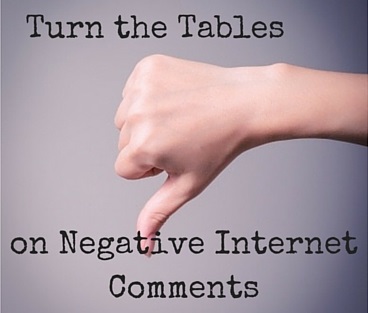 When is a negative internet comment not such a bad thing? The answer—when you use it to your advantage.
When is a negative internet comment not such a bad thing? The answer—when you use it to your advantage.
I talked before about the importance of reputation management. For the small business owner, the word on the internet can make or break your business. You have to be on top of it. That means vigilance. While there are a number of tools to help you track comments made about your business or brand, Google Alerts is easy and free. If you are not using it—you should.
Let’s say you do all the right things. You are using CRM software, you have a great business plan, and a tight storefront with well-trained, engaged employees. Super. Things will never go wrong—right?
That is incorrect. No matter how well you run your business, there are going to be mistakes, a customer or client is going to get left out in the cold—and they are going to complain. Trust me. As an experienced small business owner, I know the pain of mistakes that just should not have been made.
Sometimes, though, there was no mistake. You just have an unhappy client, or someone trying to stir up trouble for your business. Does it happen? A lot.
Take advantage of a poor review
We already know that online reviews are important. People believe what they read, often without considering the credibility of the reviewer, or the circumstances behind a complaint. So let’s take a look at how to turn a profit on a bad situation:
- First rule? Do not ignore a complaint: Squeaky wheels get grease and a lot of play on the internet. Ignoring a problem, and hoping it goes away, is a fast way to lose money and hurt your reputation. Remember—people do not often question the credibility of someone who complains. So why respond to people who don’t have anything nice to say? Because you can use the exposure.
- Free publicity is not a bad thing—especially if it gives you a chance to look good. So look good. Because you are monitoring your online reputation, you know right away about the problem. Gather as much information as you can, but intervene quickly on social media. Respond to your accuser by owning the problem—and ask for more information. Do not create a reason for the error—just own it. “I understand you are unhappy about how you were treated, and I want to make that right.” Step up to the problem—absolutely, and quickly.
- Do not delete: Deleting a comment is possibly worse than ignoring it. It shows you saw it and are not taking action to address the problem.
- With bigger or business process problems, you are probably getting more than one complaint, and word spreads fast. Post a note on your website, or via social media, or tell customers you are aware of the problem and working to resolve it. After you have corrected the problem, take the opportunity to briefly discuss the problem, but take more time to talk about how you fixed it. Make it a case study in how to do things right. Add an apology and a discount, coupon, or other perk, to help your customers feel like they were part of the solution—instead of the problem.
- What if someone is targeting your site, or establishment, on social media? Your best defense is an honest response. If your attempts to resolve the problem or the complaint are rebuffed, use social media to show all you do for your clients. Restate the complaint you received, mention what you did in response, and how you offered to resolve their difficulty. The people you want as customers or clients will see and consider your response. They will also see the complainer as unreasonable if you did your best to respond in good faith.
You cannot please all of the people all of the time. But when you treat people who complain with respect, courtesy, and generosity, they usually respond in kind.
After you resolve the situation, take advantage of the feedback to take a hard look at what you could do to avoid a similar complaint or mistake. Complaints are just outside interests helping you troubleshoot your own business—take advantage of the information, and the opportunity.
As a small business owner, I know how to turn the tables on hard times to help you earn your first million. Get a super start on the New Year by attending one of my free webinars, or give me a call at 585-633-7563 today.
Yours in profit,
Bob Britton
